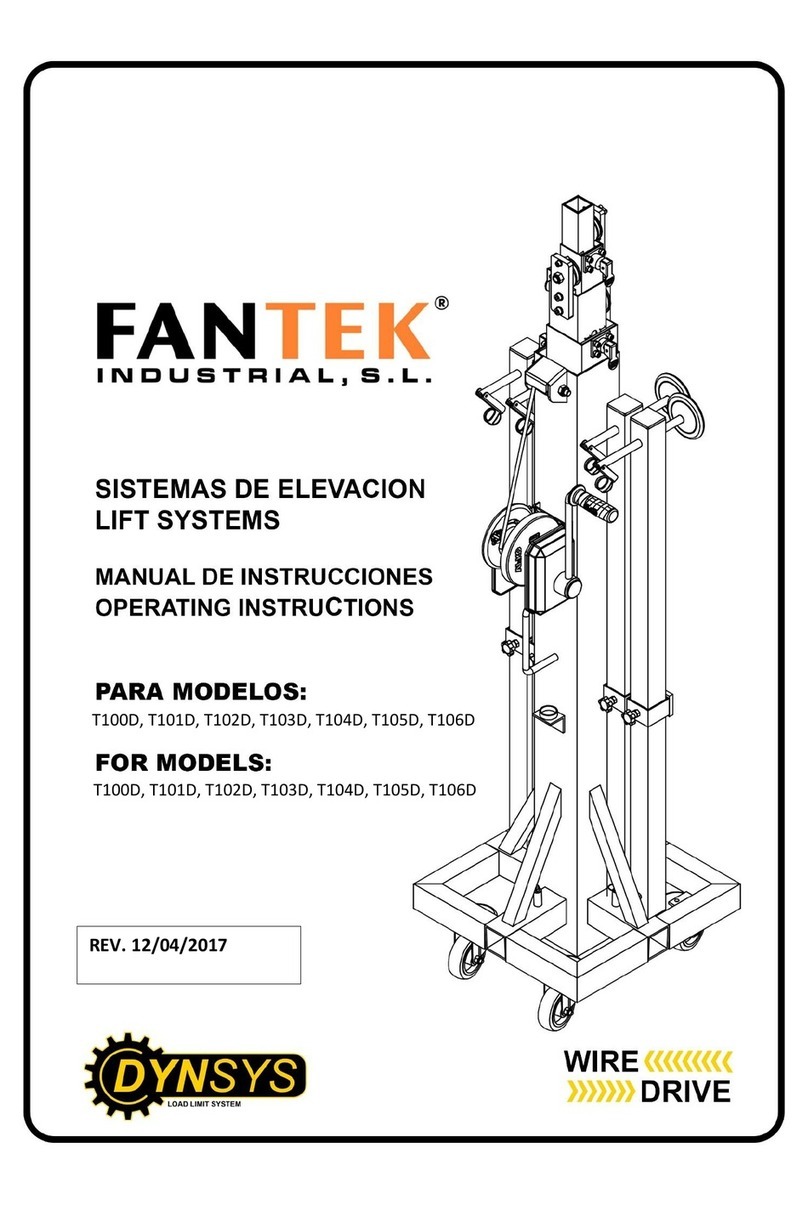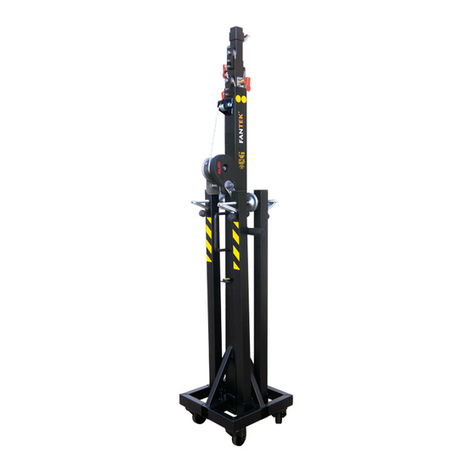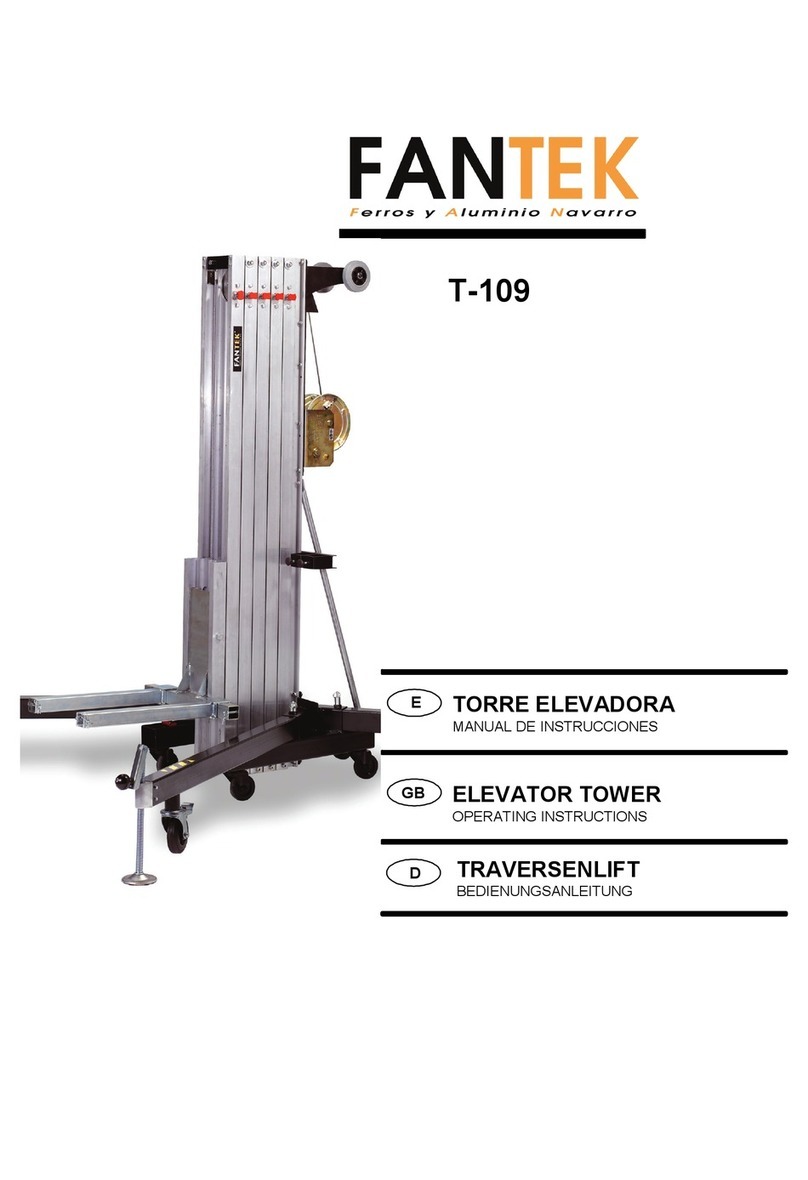
USER MANUAL FOR FT TOWERS 2
IMPORTANT
Read and carefully understand all points and
aspects of this manual. Loads irresponsibly can
cause lethal accidents. Installation of lifting
systems and proper use are only responsibility of
the user.
It is recommended to attach this manual with the
tower system used.
In case of doubt, consult the technical
department of FANTEK Industrial.
CONTENT
IMPORTANT ....................................................... 2
CONTACT ............................................................ 2
ILLUSTRATION INDEX ......................................... 2
WARNING ICONS ............................................... 3
RULES AND SAFETY USE ..................................... 3
PARTS IDENTIFICATION ................................... 10
OPERATING MODES ......................................... 11
OPERATING MODE AS MECHANISM
(MECHANISM MODE) ............................. 11
OPERATING MODE AS STRUCTURE
(STRUCTURAL MODE) ............................. 11
HOW TO USE STEP BY STEP ............................. 12
LINE ARRAY ELEVATION IN MECHANISM MODE
.......................................................................... 12
LINE ARRAY ELEVATION IN STRUCTURE MODE 16
.......................................................................... 16
TRUSS SYSTEM ELEVATION IN MECHANISM
MODE ............................................................... 21
TRUSS SYSTEM ELEVATION IN STRUCTURE
MODE ............................................................... 25
.......................................................................... 25
USING THE TOWER IN STRUCTURE MODE
(WIND CONDITION) ......................................... 30
ACCESSORIES ................................................... 30
PLACING THE LOAD .......................................... 31
LOAD CHART .................................................... 32
DYNAMIC OVERLAP ......................................... 34
DGUV V17/18 NORM REGULATION.
Explanation ............................................. 35
SPECIFICATIONS ............................................... 36
DECLARACION DE CONFORMIDAD /
DECLARATION OF CONFORMITY ...................... 37
DGUV MARK .................................................... 38
CONTACT
Internet: http://www.fantek.net/
ILLUSTRATION INDEX
Figure 1 ........................................................................................... 4
Figure 2 ........................................................................................... 4
Figure 3 ........................................................................................... 4
Figure 4 ........................................................................................... 4
Figure 5 ........................................................................................... 5
Figure 6 ........................................................................................... 5
Figure 7 ........................................................................................... 5
Figure 8 ........................................................................................... 5
Figure 9 ........................................................................................... 6
Figure 10 ......................................................................................... 6
Figure 11 ......................................................................................... 6
Figure 12 ......................................................................................... 6
Figure 13 ......................................................................................... 7
Figure 14 ......................................................................................... 7
Figure 15 ......................................................................................... 7
Figure 16 ......................................................................................... 7
Figure 17 ......................................................................................... 8
Figure 18 ......................................................................................... 8
Figure 19 ......................................................................................... 8
Figure 20 ......................................................................................... 8
Figure 21 ......................................................................................... 9
Figure 22 ......................................................................................... 9
Figure 23 ......................................................................................... 9
Figure 24. ...................................................................................... 10
Figure 25 ....................................................................................... 11
Figure 26 ....................................................................................... 12
Figure 27 ....................................................................................... 12
Figure 28 ....................................................................................... 12
Figure 29 ....................................................................................... 13
Figure 30 ....................................................................................... 13
Figure 31 ....................................................................................... 13
Figure 32 ....................................................................................... 13
Figure 33 ....................................................................................... 14
Figure 34 ....................................................................................... 14
Figure 35 ....................................................................................... 14
Figure 36 ....................................................................................... 14
Figure 37 ....................................................................................... 15
Figure 38 ....................................................................................... 15
Figure 39 ....................................................................................... 15
Figure 40 ....................................................................................... 15
Figure 41 ....................................................................................... 16
Figure 42 ....................................................................................... 16
Figure 43 ....................................................................................... 17
Figure 44 ....................................................................................... 17
Figure 45 ....................................................................................... 17

































